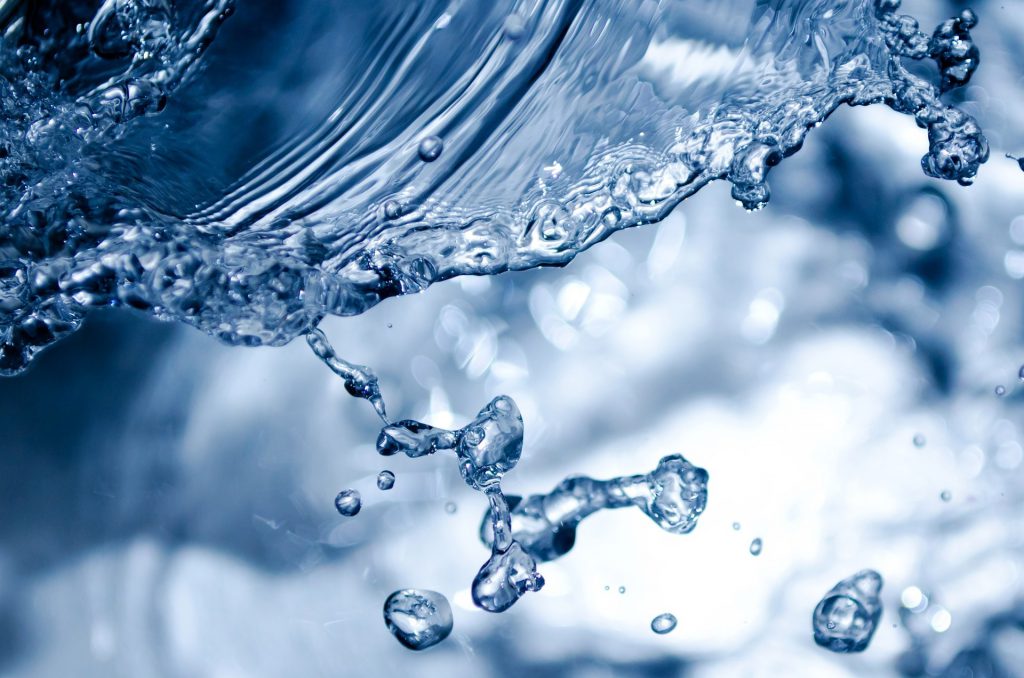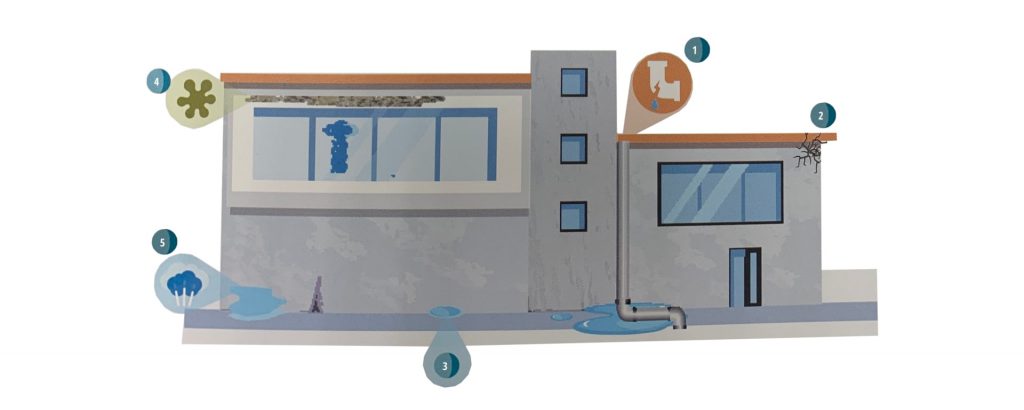
[:en]In the previous blog we talked about how waterproofing saves you a fortune: a brief introduction on waterproofing, the damage potential of water leaks which highlights the importance of proper waterproofing. Today we are going to talk about 5 of the biggest challenges buildings face with leaks.
Observe the image below, and note the numeration. Each point correlates to its corresponding number.

1. Water leaks through pipes.
- Deterioration: With time, metal will rust and start leaking.
- Temperature change: Abrupt temperature shifts will cause quick expansion and contraction leading to cracks.
- Water pressure: Unregulated water pressure may cause the pipe to burst.
- Clogs: Creates irregularity in water pressure, also potentially yielding a burst.
Pinhole leaks are common in pipes delves into this issue further and discusses causes.
2. Water leaks through roofs.
Arguably the most common culprit.
- Bad workmanship: Since a lot of manual labor is involved, waterproofing is prone to human error.
- Tears and wears: Most commonly occurs due to post membrane installation drilling, expansion joints shifting.
- Too much exposure to UV: UV light accelerates the membrane’s deterioration rate, therefore it’s important to protect the membrane layer from sunlight.
- Selecting the wrong product: Different waterproofing products are applied for different conditions. For example, an APP type membrane is not designed to withstand cold temperatures, and applying it to a cold environment will see the membrane crack.
Ten common reasons for roof leaks brings up even more causes.
3. Water leaks through walls.
Walls draw moisture by capillary action from the underlying soils and rocks; moisture that contains salt. Once the moisture reaches heat and air it will evaporate out of the wall. But the salts remain both in the wall in a crystal form and on the wall surface. As the salt crystals multiply, it’ll wear down the wall where visible traces can be seen.
4. Vapor causing mold on roofs.
Vapor usually forms from heat, showers, cooking, and even breathing. These factors contribute to the accumulation of vapor on walls and ceilings, especially the colder corners. This vapor accumulation is an ideal condition for unwanted organic growth.
This article discusses the impact of mold on health; who’s at risk, and what you can do to avoid it.
5. Moisture accumulating inside the structure’s foundations.
Without proper foundation proofing, moisture’s accumulation on building foundations results in faster deterioration.
To conclude, be on the lookout for these 5 challenging spots, and always try to catch problems at an early stage. The longer you wait, the harder it is to fix. You may also be interested in a quick, economic, and easy to use remedy for water leaks. Sign up here to learn more about our new and revolutionary LAMASTICK.[:ar]
في مدونتنا السابقة “العزل المائي يوفر لك ثروة“، قمنا بإعطاء مقدمة عن العزل المائي والاضرار المحتملة عند حدوث تسرب للماء مما يظهر أهمية العزل المائي الصحيح. واليوم سنتحدث عن أكبر خمسة تحديات التي تواجه الابنية والمتعلقة بأضرار الرطوبة.
الشكل التالي يبين مواقع هذه التحديات الخمسة حسب الرقم المدون بجانب المكان:

١ تسرب المياه من المواسير:
- تلف المواسير والقطع الصحية مع الزمن بسبب الصدأ والقدم مما يؤدي الى حدوث التسريب.
- التغيرات الحرارية العالية والتي ممكن أن تسبب تمدد وتقلص سريع يسبب التصدع.
- الضغط العالي في القطع الصحية الذي قد يؤدي الى انفجارها.
- الانسدادات في المواسير قد تسبب عدم انتظام بتصريف الماء وبالتالي خروج الماء في مسارات أخرى.
- هذا الرابط يبحث باستفاضة اكثر في هذا الموضوع.
٢ تسرب المياه بسبب عدم احكام الغلاف الخارجي للمبنى:
ربما يعتبر هذا التحدي هو أصل المشاكل في تسربات المياه في المباني وعادة يكون للأسباب التالية:
- سوء المصنعية، وذلك لأن اعمال العزل المائي تتطلب عمل يدوي وخبرة ولهذا فإن العزل هنا يكون عرضة للخطأ البشري.
- التلف الذي ممكن أن يحصل لطبقة العزل المائي بعد التركيب بسبب الاعمال الميكانيكية المتبقية على السطح كتركيب البلاط وخزانات الماء والاطباق اللاقطة…
- ترك طبقة العزل المائي مكشوفة ودون حماية وعرضة للعوامل الجوية والاشعة فوق البنفسجية مما يؤدي إلى تقصير العمر الافتراضي للعازل.
- اساءة اختيار المادة المناسبة للعزل المائي، كأن يتم اختيار طلاء عازل في المكان الذي يستوجب استعمال غشاء مسلح أو اختيار عازل معالج بالبولي بروبلين بدلا من الأس بي أس في الامكان الباردة جداً.
هذا الرابط يبحث باستفاضة اكثر في هذا الموضوع.
٣ تسرب المياه عبر الجدران المتصلة بالأرض وعبر الاساسات:
وذلك بسبب الرطوبة الصاعدة بالخاصة الشعرية من التربة الملامسة للأرضيات والجدران والاساسات، بحيث تظهر الرطوبة في جدران الطوابق الأرضية وقد تصل الى ارتفاع حوالي 90سم عن منسوب البلاط. وتبدو بشكل افقي ومتعرج على الجدار، وتترك ترسبات ملحية عند جفافها.
٤ تكاثف بخار الماء على الاسطح الداخلية والخارجية مما يساعد على تكون العفن:
إن مصدر بخار الماء هذا يكون بالعادة من التدفئة الداخلية والغسيل والاستحمام والطبخ بالإضافة الى التنفس. كل هذه المصادر تؤدي لتكاثف الماء على الجدران أو الاسقف وبالأخص في الزوايا الأكثر برودة والملاصقة للأسطح الخارجية. وهذا التكاثف يكون بيئة خصبة لنمو العفن في هذه الزوايا.
هذا الرابط يبحث بتأثير هذا العفن على الصحة، والأخطار المتعلقة بذلك. كما يورد السبل المناسبة لمعالجة الموضوع..
٥ الرطوبة داخل العناصر الانشائية من جدران وارضيات مما يؤثر على وظيفتها:
يحصل التكاثف الجوفي داخل العناصر الانشائية للمبنى في المواضع التي تكون درجة حرارتها مساوية او اقل من درجة الندى في أثناء انتقال بخار الماء عبر عناصر البناء. يجب استخدام طبقة عازلة للبخار هنا لمنع هذا الانتقال وخاصة ضمن الجدران الخارجية للمبنى. ينتقل بخار الماء بفعل الفرق في الضغط بسبب اختلاف الحرارة والرطوبة النسبية للهواء بين داخل المبنى وخارجه.
[:]
